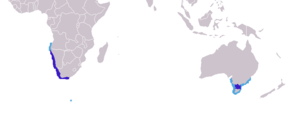South African fur seal
| South African fur seal | ||||||||||||
|---|---|---|---|---|---|---|---|---|---|---|---|---|

A pack of South African fur seals ( Arctocephalus pusillus ) |
||||||||||||
| Systematics | ||||||||||||
|
||||||||||||
| Scientific name | ||||||||||||
| Arctocephalus pusillus | ||||||||||||
| ( Schreber , 1775) |
The South African fur seal ( Arctocephalus pusillus ) is a species of the southern fur seal . Its naming is imprecise as it not only lives on the South African coast, but also in Australia .
features
With a length of 250 cm (males) or 180 cm (females) this is the largest species of the genus; Unfortunately, the Latin name of the species pusillus literally means “the smallest”, so that the name “pygmy fur seal”, which is absurd in view of its size, has become established for this species.
distribution
The subspecies A. p. pusillus founds colonies on the Atlantic coasts of South Africa and Namibia (e.g. at Cape Cross ). Outside the mating season, individual animals also migrate up the coasts to Angola and can be found on the sub-Antarctic Marion Island .
The other subspecies is A. p. doriferus , the Australian fur seal - the German name can lead to confusion with the New Zealand fur seal , which is also native to Australia . Its colonies live exclusively on nine islands in the Bass Strait . Outside of the mating season, the seals scatter to other Australian and Tasmanian coasts.
Inventory development
After this species was brought to the brink of extinction in the 19th century , the populations have noticeably recovered today. There are over 1.5 million fur seals on African coasts - especially on the coast of Namibia , where individual colonies can contain over 200,000 animals ( Cape Cross ).
South African fur seals are still hunted in Africa. But unlike in the past, it is a controlled hunt for a set number of young males. It is no longer only the skins that are processed, but also the meat and fat. In Namibia, annual hunting quotas of 86,000 animals were set between 2010 and 2012.
Originally several hundred thousand fur seals of this species lived on the Australian coasts; By the 1940s the almost exterminated population had grown again to 25,000 animals, today to 50,000.
Hazard and protection
The South African fur seal is listed as Least Concern on the Red List of Endangered Species of the International Union for Conservation of Nature ( IUCN ).
Nevertheless, like all species of its genus Arctocephalus, it is listed in the Washington Convention on the Protection of Species, CITES, Appendix II, which restricts trade worldwide. The European Union has also adopted this restriction in the EU Species Protection Regulation (EC) No. 338/97 Appendix B. This regulation automatically obliges all EU member states to protect. This is reflected in the Federal Republic of Germany in the Federal Nature Conservation Act , where the species is designated as particularly protected.
Web links
- Images of Arctocephalus pusillus
- Arctocephalus pusillus in the endangered Red List species the IUCN 2009. Posted by: Hofmeyr, G. & Gales, N. (IUCN SSC Pinniped Specialist Group), 2008. Retrieved on January 10 of 2010.
- The CITES Appendices. September 25, 2012, accessed on October 16, 2012 (English, The Appendixes of the Washington Convention on Species Conservation, CITES).
- WISIA Tracing Service for Endangered Species. In: WISIA Online. German Federal Agency for Nature Conservation, accessed on January 10, 2010 .
Individual evidence
- ↑ Quota set for seals ( Memento of February 22, 2014 in the Internet Archive ) Allgemeine Zeitung, July 7, 2010


